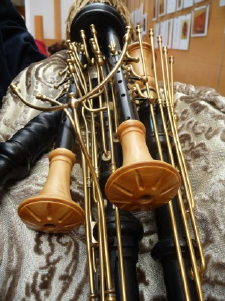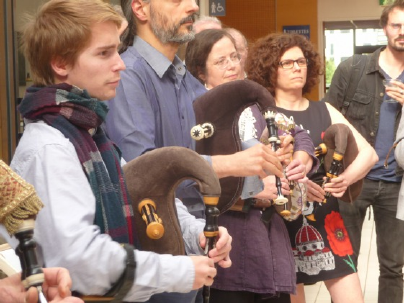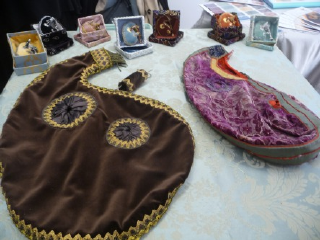The Bagpipe Society
Review of the Musette Conference
Review of The Musette conference by Andrea Kirkby
The musette is an anomaly in the piping world; an ’elite’ art-music instrument, forever identified with the nobility of the court of Louis XIV at Versailles. It may present itself as a pastoral instrument, but it has as much to do with real sheep and shepherds as Florence Foster Jenkins did with bel canto.
The musette had been lost from sight after the French Revolution - arguably, it was already obsolete by the time the ancien régime caved in - until Jean-Christophe Maillard rediscovered the instrument and its repertoire, and Rémy Dubois started making copies of original instruments. It was appropriate, then, that the recent conference on the musette in Rouen began with homage to Jean-Christophe (who died in 2015) and a paper by Rémy.

The musette world seems slightly schizophrenic, reflecting the double nature of the instrument; names such as Eric Montbel, Dominique Paris, and Rémy Dubois, who all gave papers, will be familiar to Saint-Chartier and Son Continu attendees, but other papers were given by academics in the classical music world like Amanda Babington (a sole English representative), Florence Getreau (Centre National de la Recherche Scientifique) and Vincent Robin. A few people, like François Lazarevitch, whose Musiciens de Saint Julien gave a concert as part of the proceedings, straddle the two worlds - he started with cornemuse du centre and cabrette before tackling what he describes as the “Hotteterre trio” of flute, recorder and musette de cour.
Conference papers addressed every aspect of the musette de cour from its repertory and iconography to its bibliography and playing style. Although with two methods (Borjon and Hotteterre) devoted to the instrument, and a page of engravings in the great Encyclopédie of Diderot, it’s easy to think we know a lot about the musette, once you start investigating you find how little these primary sources really tell us.
For instance, there’s a whole prehistory to the musette de cour which Rémy Dubois illustrated with his notes on the Ambras instrument, and Eric Montbel and Marco Tomassi with their lecture on the recreated sourdeline. This was particularly interesting as it links the zampogna with the musette de cour through the presence of French traveller François Langlais in Rome, where Manfredo Settala had invented the sourdeline; both men are shown in portraits with the instrument, easily recognised with its two chanters and complex keywork. (One of the challenges of making the instrument is finding an alloy that will make 30 cm long keys that don’t bend.) The sourdeline’s deep, rich voice was heard throughout the three days, adding a certain gravitas to the massed musettes.
Throughout the three days the sound of musettes was rarely absent; I heard piping the moment I arrived on Monday morning, and it kept going all the way to the final bal. There were a number of concerts, as well as an interesting collaboration between Marie-Ange Petit, the Arts Florissants percussionist, and
Patrick Blanc showing how the musette can work with percussion to address a 16th and 17th century repertoire. Amanda Babington played a piece of Niel Gow’s music on musette at the end of her lecture, and there was a lunchtime concert joining flute (Camille Breger) and musette (Merryl Luchart), an unexpected but excellent combination. Coffee and lunch breaks became mini-sessions, and there were mass play-throughs with a good-sized musette orchestra
(and the sourdeline, too). The last day saw the conference transfer from the heights of Mont Saint-Aignan to the centre of Rouen for a concert of musette, flute, recorder and the cathedral Carillon, bringing Van Eyck’s dual career as carillonneur and wind player into a unique perspective, before a final bal baroque closed the sequence of events. This may have been an academic conference but it had a good deal of the Saint-Chartier feeling to it.

One interesting feature of the musette repertory is the predominance of sets in parallel major and minor keys, a characteristic of the French baroque. The fully chromatic nature of the musette makes this easily achievable. Some of the repertory also uses the presence of the second chanter to enable polyphonic playing.
Players’ ability to access this repertory has changed dramatically over the past two decades, as Dominique Paris pointed out in his lecture on open source scores. The earliest rediscovery of the French baroque repertoire was made by recorder players, many of the 1950s and 1960s editions not even mentioning the instrument for which the pieces were originally written. From the 1980s, facsimile editions came to the fore, but these remained expensive; most musette players became used to extensive photocopying missions. Most recently, the Bibliothèque Nationale’s online collection, Gallica, has put digitised copies of many original editions online, becoming the main source for most musette players.
The increasing use of facsimiles and original editions has had interesting results. Every player at the conference could confidently handle French violin clef (G clef on the first line of the stave) and eighteenth-century printed music. That could prove a barrier for many pipers not used to the conventions of the French baroque.

The conference ended with a double gig by François Lazarevitch; a lecture on articulation and phrasing, and a masterclass for three players. The masterclass was incredibly detailed work; at one point he spent five minutes on a single bar, discussing the silences between the notes (enabled by closed fingering) and the effect of each choice made on the phrasing of the music. Lazarevitch began by saying “I am not a musicologist,” but his list of sources was impressive, going far beyond Borjon and Hotteterre. He cited methods for other instruments
(Quantz and Tromlitz for flute, Couperin and CPE Bach for keyboard), a fascinating work of 1775 by Engramelle on making cylinders for music boxes, and even Jacques Brel (doubled consonants in ‘Ne me quitte pas’). (We often hear the lament that there were no recordings of baroque music. But there were! The serinette, a little machine intended to teach caged birds to sing, has a quite extensive repertoire of recorded songs - another interesting resource for studying baroque articulation - and quite a few of these added interest to the soundtrack for the lecture.)
Attending this conference was a marvellous experience. There are perhaps few instruments where you can gather most of the world’s experts in a single room; impossible for, say, the violin or piano, and difficult even for baroque oboe or hurdy gurdy. It was well funded, too, with a number of regional and cultural funds contributing as well as the University; I doubt the conference would have attracted such largesse had it been held in the UK. However, there are two areas where things might have been done better. I found out about the conference simply because I live close to the La Couture-Boussey wind instrument museum, which was one of the conference’s partners. The conference doesn’t appear to have been well advertised, and could have been much better attended if it had been. Secondly, if you don’t speak French, and don’t read French violin clef, and don’t have a few thousand euros spare, the musette remains an unapproachable instrument. It was an elite instrument in the eighteenth century and it remains one today; Christine Donnard’s beautiful robe royale bag cover costs more than I paid for my first bagpipe! While a Yamaha plastic musette isn’t on the way any time soon, there does need to be some thought given to expanding the musette’s world beyond a small group of aficionados. (While this was an entirely francophone conference, English language abstracts of the papers were supplied - a step in the right direction.)
I should point out this isn’t anglophone sour grapes; a number of other participants expressed the same thoughts about the ’elite’ musette and the desire to “s’échapper un peu du monde baroque, du monde de Versailles” (“escape the baroque world of Versailles for a moment”). Eric Montbel even gave a shout-out to the Bagpipe Society and Chanter, wishing France had a similar organisation to promote the interests of all bagpipes - and then suggesting future research might look at cabrette playing, which he believes is directly influenced by the performance practice of the last generation of musette players.
Whether such thoughts will bear fruit remains to be seen. But certainly to judge from the quality of many of the papers given, and the standard of playing, over the course of the conference, the musette is in good health - and in good hands.
From Chanter Autumn 2019.
- Data Processing Notice (GDPR)
-
@BagpipeSociety on X (formally known as Twitter)
-
TheBagpipeSociety on Instagram
-
 BagpipeSociety on Facebook
BagpipeSociety on Facebook
Something wrong or missing from this page? Let us know!
